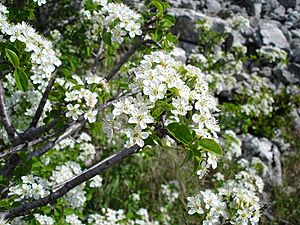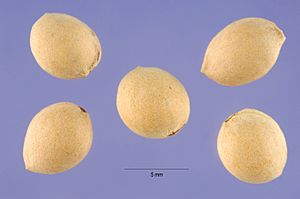Mahaleb cherry facts for kids
Quick facts for kids Mahaleb cherry |
|
|---|---|
 |
|
| Spring flowers of St. Lucie cherry | |
| Conservation status | |
| Scientific classification | |
| Synonyms | |
|
List
|
The mahaleb cherry or St. Lucie cherry (scientific name: Prunus mahaleb) is a type of cherry tree. People grow this tree to get a special spice from its seeds. These seeds are found inside the cherry stones. The spice has a nice smell and tastes a bit like bitter almonds mixed with cherry.
This tree naturally grows in central and southern Europe, Iran, and parts of central Asia. It is also found in northwestern Europe, where it might have grown naturally or spread over time. It is a deciduous tree or a large shrub. This means it loses its leaves in the fall. It usually grows to be 2 to 10 meters tall, but sometimes it can reach 12 meters. Its trunk can be up to 40 cm wide.
Contents
What the Mahaleb Cherry Looks Like
The tree's bark is grey-brown. Young branches have small dots called lenticels. Older trunks have shallow cracks. The leaves are about 1.5 to 5 cm long and 1 to 4 cm wide. They grow in clusters on the twigs. Each leaf is oval-shaped with a pointed tip and jagged edges. They are smooth and green.
The flowers are very fragrant and pure white. They are small, about 8 to 20 mm wide. Each flower has a stem about 8 to 15 mm long. The flowers grow in groups of 3 to 10 on a longer stem. Bees are the main helpers for pollination.
The fruit is a small, cherry-like drupe. It is about 8 to 10 mm wide. At first, it is green, then it turns red, and finally dark purple or black when it is ripe. The fruit tastes very bitter. The tree flowers in the middle of spring, and its fruit ripens in the middle to late summer.
This tree produces many flowers, but not all of them turn into fruit. This helps the tree make sure that the fruits it does produce are of good quality. This also makes the seeds inside the fruit stronger.
Where the Mahaleb Cherry Grows
The Prunus mahaleb tree grows in thick forests and open woodlands on dry hills. In central Europe, it can be found at heights up to 1,700 meters. In southern Europe, it grows in highlands between 1,200 and 2,000 meters high.
It has also started growing naturally in some other places with mild weather. These include parts of Europe north of where it originally grew, like Great Britain and Sweden. It can also be found in some areas of Australia and the United States.
How Birds Help the Mahaleb Cherry
Scientists have found that the Mahaleb cherry depends on certain birds in southeastern Spain. Four types of fruit-eating birds help the tree. Blackbirds and blackcaps are the most important birds for spreading the seeds.
When the Mahaleb cherry has fruit, these birds eat almost only its fruit. Then, they spread the seeds to new places where the tree can grow well. The way these birds eat the fruit and the places they live can even affect which types of Mahaleb cherry trees grow best.
Growing the Mahaleb Cherry
Outside of its natural home, the Mahaleb cherry is grown as an ornamental tree. People like its strong-smelling flowers. It is grown in many places around the world that have mild climates.
There are different types of Mahaleb cherry trees that people have chosen for their beauty. For example:
- 'Albomarginata' has leaves with different colors.
- 'Bommii' is a small tree with branches that hang down.
- 'Globosa' is a small, round tree.
- 'Pendula' has drooping branches.
- 'Xanthocarpa' produces yellow fruit.
Uses of the Mahaleb Cherry
The plant is grown for mahleb, which is a spice. This spice comes from the seeds inside the cherry stones. It smells nice and tastes like bitter almonds. People use a small amount of mahleb to make sweet foods taste better. For example, it is used in the Turkish sweet-bread called çörek and the Greek sweet-bread called tsoureki. It is also used in the Armenian sweet-bread called chorak.
The spice is made by grinding the seed kernels into a powder. Sometimes, oil is taken from the seeds instead.
The wood of the Mahaleb cherry tree is hard. It is used to make cabinets and pipes.
The bark, wood, and seeds of the tree contain a substance called coumarin. This substance can help with swelling, make people feel calm, and help blood vessels widen.
It is important to know that the fruit of the Prunus mahaleb is not safe to eat.
History of the Mahaleb Cherry
The Prunus mahaleb tree might be the "ḫalub-tree" mentioned in very old Sumerian writings. These writings describe a strong, fruit-bearing tree with seeds and leaves known for their healing powers. This tree was linked to the goddess Inana.
The Arabic word "mahleb" or "mahlab" for the Mahaleb cherry appears in old Islamic writings. Famous scholars like Muhammad ibn Zakariya al-Razi (who died around 925 AD) and Ibn al-Baitar (who died in 1248 AD) wrote about it. Ibn al-Awwam, in his book about farming from the late 1100s, explained how to grow the Mahaleb tree. He said it grows well and is easy to care for, but it needs water and cannot handle long dry periods. He also described how to prepare the mahleb seeds by boiling them in sugared water.
The word "mahaleb" was not common in Latin until later. In 1317, an encyclopedia by Matthaeus Silvaticus mentioned "mahaleb" as the kernel seed from both wild and farmed cherry trees in Arabic countries. In 1479, a medical-botany book by Ioannis Mesuae spelled it "almahaleb." In 1593, the botanist Carolus Clusius used the spelling "mahaleb."
Today, the Mahaleb cherry is mostly grown and used in the areas that were once part of the Ottoman Empire. Syria is the main country that exports it.
See also
 In Spanish: Cerezo de Santa Lucía para niños
In Spanish: Cerezo de Santa Lucía para niños



